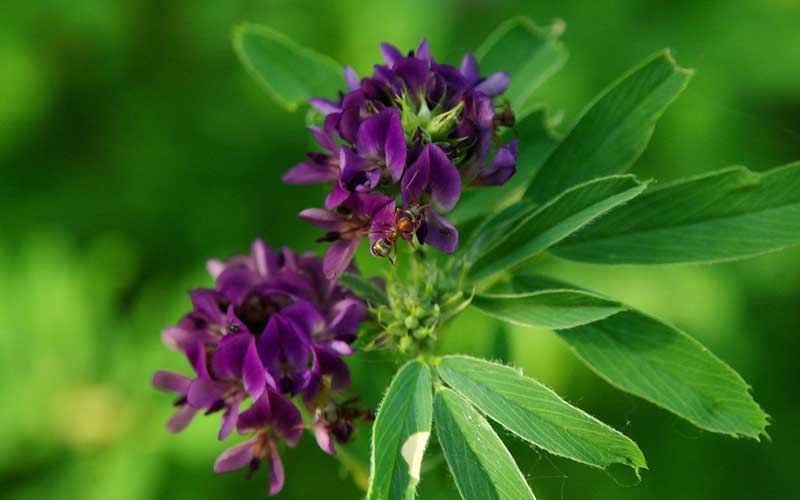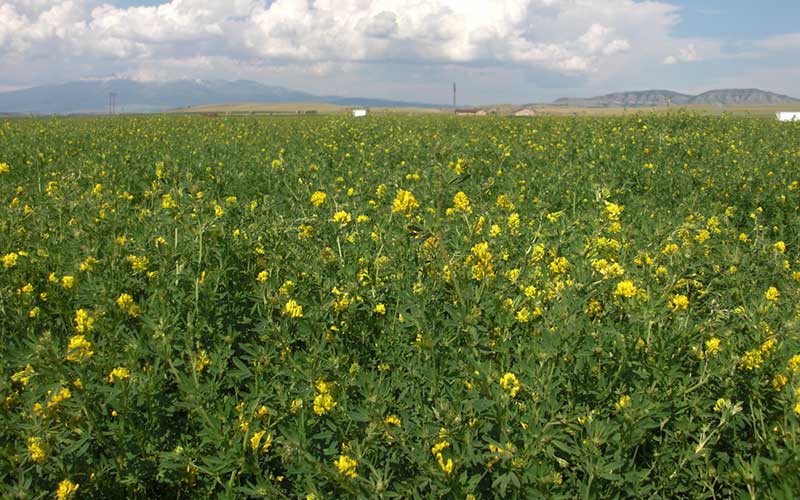
This is where you find all our press releases and news articles.

Alfalfa is a high-protein perennial legume with a crude protein content of about 18-20%.
It usually lasts four to five years and is predominantly used for silage or hay, with some aftermath grazing. It has an energy value of about 10-11ME and average dry matter yield of 15t/ha.
Alfalfa grows off a taproot that stores nutrients to help the plant regrow after it has been cut or grazed.
Like other legumes such as clover, peas and beans, there are nodules on its roots that contain nitrogen-fixing bacteria, so the crop needs no additional applied nitrogen (N) to grow.
There have been some reports of alfalfa roots going down as far as 15m in search of water.
Alfalfa requires a free-draining soil with a pH of 6.2 or more. It does not tolerate heavy soils, waterlogging or acidity.
Alfalfa should be established when the soils are warm and at a consistent 7-8C or above. It can be sown from the end of April until mid-August.
The crop is slow to establish in the first year, so later autumn sowing should be avoided, as it can lead to a patch establishment into winter.

Undersowing can be a useful way to establish alfalfa, as it means the field is not out of production while the crop establishes.
When undersowing, the general rule of thumb is to reduce the cereal component by one-third – for example, reducing the cereal rate from 187.5kg/ha to 125kg/ha – to give the alfalfa seedlings space and light to develop.
Alfalfa should be sown when soils are warm into a fine and firm seed-bed, no deeper than 1cm. Very small seeds can fail to emerge when sown too deep. Fields must be rolled before and after drilling to ensure good soil-to-seed contact.
Alternatively, it can be grown with non-aggressive grasses that will not outcompete the seedlings, such as Timothy or meadow fescue.
Based on 2018 figures, a rough establishment cost per crop per year (over five years) would be £105/ha (see below for a cost breakdown).
Alfalfa requires no N once established, but it can be beneficial to apply 25kg N/ha to an autumn sowing to promote rapid plant development. P and K should be kept at Adas index 2 to maintain yields.
In the year of sowing, a light cut may be taken in mid-August at the early flowering stage. If conditions are favourable, a second light cut, or grazing, may be taken in mid-autumn.
If it has been sown during midsummer, it’s unlikely there will be much to cut that year.A rotation of five years is recommended between Alfalfa crops, to reduce the likelihood of disease issues.
The crop should be cut to a stubble length of 10cm minimum.
In the first full harvest year, it should be ready for cutting in May/June at almost full flowering. Thereafter, cut at the bud stage, every five or six weeks. This provides the best balance between yield and forage quality.
After cutting, the crop must be wilted to a minimum dry matter content of 30% (40-50% if baling) to concentrate the sugar content.
Up to 70% of the protein and 90% of the minerals and vitamins in the plant reside in the leaf, so it is important to minimise leaf losses.
As the leaf dries out more quickly than the stem of the plant, overwilting or extensive handling can result in large amounts of leaf shatter.
The use of roller-type mower conditioners, which cut and condition the alfalfa by crimping or crushing the stem, is advisable when harvesting. These will speed up the rate of moisture loss from the stem without extensive damage to the leaf.
Alfalfa can be silaged as either bales or chopped and put into the clamp. It can then be fed as part of a ration with other silage, such as grass or maize. It can also be made into hay or haylage.
The target freshweight (FW) production a year is 40t/ha, with a target annual DM yield (at 30% DM for silage) of 12t DM/ha.
The high protein content of alfalfa silages make it a good replacement for soya bean meal in diets. It is also a good complement to maize silage.
For ruminants, the lower readily available starch content and higher buffering capacity of alfalfa compared with maize silage also has a beneficial effect on rumen pH. Hard grazing can cause excessive damage to the plant crowns.
Related News
Reasons why the grass/alfalfa pellet machine oil pump is not oiling
Alfalfa Feed Pellet Plant Build Alfalfa Pellet Production Line
Can the Alfalfa Pellets Produced by the Feed Pellet Machine Be Fed to Horses?
Large-scale Feed Pellet Plant 5t/h Ring Die Alfalfa Pellet Machine for Sale
Having the right mix of reliable, high-quality pellet machine and pelletizing systems and expert support is essential to your success. Watch how our end-to-end feed pellet plant solutions have helped our customers optimize their performance.
Our customized and future-proofed turnkey pellet plant solutions is designed with you at the core. From vision to reality and beyond, our team stays connected with yours. Giving you peace-of-mind with an expert at your side.

At RICHI, we go beyond project completion. With RICHI Servicee, we’re your dedicated partners in success. Count on us for expert guidance, minimal downtime, and optimized productivity. Choose RICHI for unmatched service and support.



Meet global product demands and quality standards with industry-leading pellet plant design, engineering, equipment, and construction services for pellet processors.


Your Partner Beyond Project Completion
2000+ cases
RICHI is the leading designer, manufacturer and builder of pellet plants in the world, completing over 2000 projects in 140 countries across 6 continents.
Read More
Increase plant productivity, profitability, and safety by integrating high quality equipment into your pellet production line. Over the years, RICHI has become China's top pellet equipment manufacturer. At the same time, RICHI has established valuable partnerships with the world's leading component and raw material manufacturers to bring you the best there is in technology, automation, and efficiency in pelleting plant machinery.

For nearly 30 years, RICHI has been providing best-in-class pellet plant equipment and services to clients across a variety of industries, sizes, and needs. We pride ourselves on the knowledge and skill that each team member possesses – from our technical sales team to our process design engineers. You can count on RICHI Machinery to take your operation to the next level of innovation, quality, and success.
Need help with your pellet manufacturing plant project? Contact us today.
ANIMAL FEED
BIOMASS
WOOD
ORGANIC FERTILIZER
AQUA FEED
CAT LITTER
MUNICIPAL WASTE RECYCLING
SPECIAL PELLET PRODUCTION
RICHI Machinery continues to deliver world class pellet mill equipment, pellet plant engineering and project solutions that add value to our customers in the animal feed, wood waste, agriculture waste, organic fertilizer, cat litter and special pellet products industries. Throughout the years, we RICHI Machinery have built strong brand, becoming industry-leading pellet machine manufacturer. We value integrity, promise quality, and prioritize your success.
Learn MoreWith our expert team, we precisely implement your process engineering requirements in pellet mill and pelletizing plant systems. No matter which industry you’re in – we understand your needs and deliver solutions that meet the highest standards.
At RICHI, quality comes first. Our pellet making machine and related pellet line equipment undergo rigorous quality controls to ensure they meet the highest standards. Rely on products that are durable, safe, and efficient.
With decades of experience in pellet machine and pellet production line production, we have earned a reputation as a trusted partner in various industries. Our expertise allows us to cover a wide range of applications.
Not only do we offer premium pelleting equipment, but we are also experts at designing, building, installing, and maintaining facilities from the ground up. Our expertise is within pellt plant process design, discovering the most efficient, productive, and profitable way to handle your materials in an end-to-end cycle.

Keeping in touch with us is an effective way to solve all your problems. If you have any needs or questions, please leave your contact information, then RICHI technical consultants will send design, quotation, videos to your mailbox. You can also contact us directly via WhatsApp: +86 13838389622
Copyright©2015-2024 by HENAN RICHI MACHINERY CO., LTD. All rights reserved.